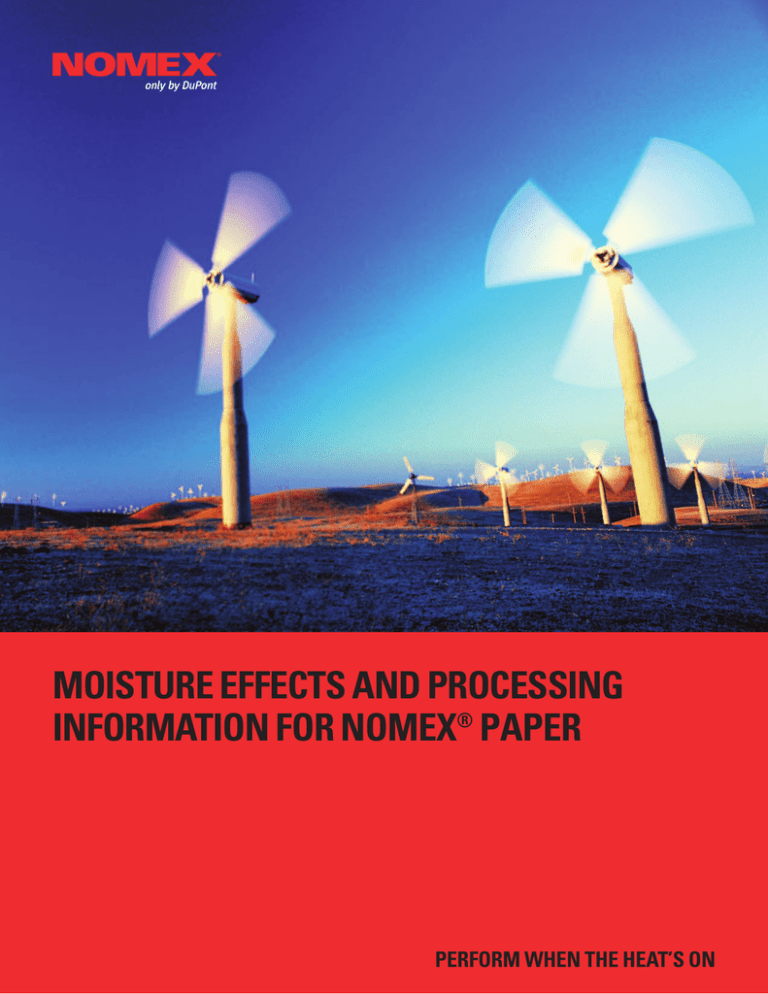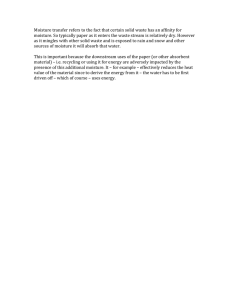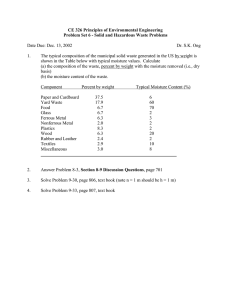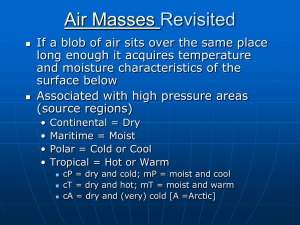
®
NOMEX
only by DuPont
MOISTURE EFFECTS AND PROCESSING
INFORMATION FOR NOMEX® PAPER
PERFORM WHEN THE HEAT’S ON1
Introduction
With increasing trends to tighter tolerances
and process optimization, the issue of
moisture absorption by DuPont™ NOMEX®
brand paper and the effect on its properties
needs to be explained. Dimensional changes
of NOMEX® paper due to moisture content
are relatively small compared to other paper
structures. Compared to film structures,
however, these changes are significant and
need to be taken into consideration at both
the design and manufacturing stages.
On the following pages, the effect of moisture
on NOMEX® paper is documented. Moisture
paper will contain after it is allowed to
The equilibrium level of moisture content for
reach equilibrium when placed in a given
NOMEX® paper is equal to ~ 1/10 of the relative
environment. If that environment is changed,
humidity of the environment to which the
the paper will attain a new equilibrium
paper is exposed.
moisture content.
As an example, if NOMEX® paper is allowed to
The moisture content of the paper depends
reach equilibrium in a relative humidity of 50%,
on the relative humidity of the surrounding
the paper will contain roughly 5% moisture
environment: the higher the relative humidity,
once it has been allowed to reach equilibrium.
the greater the amount of moisture NOMEX®
A cellulosic paper sheet in comparison will
paper will absorb.
absorb up to 7% moisture when exposed to
The moisture equilibrium level of NOMEX®
50% relative humidity. This can be seen for high
paper can be estimated by the use of a very
density pressboard products in Figure 2 below.
simple rule-of-thumb which says:
uptake and content of some typical paper
structures are described below, as well as
recommendations to minimize its impact.
Figure 1 – PAPER MOISTURE REGAIN 0.25 mm (10 mil) TYPE 410
Please note that the tests were run on hand
1. The Effect of Moisture on
NOMEX® paper
1.1 Moisture Equilibrium Level
As with most other sheet structures,
NOMEX paper is hygroscopic (absorbs
®
moisture from the surrounding environment).
Percent Moisture Content
sheets of NOMEX® paper.
The quantity of moisture absorbed will
10
9
8
7
6
5
4
3
2
1
0
96% RH
70% RH
50% RH
0
depend mainly on the relative humidity and
24
48
72
96
120
144
168
Hours Exposed at a Given Relative Humidity
the length of time the NOMEX paper is
®
exposed to the given environment.
Figure 1 shows the typical moisture
absorption characteristic of a pre-dried
Figure 2 – MOISTURE ABSORPTION OF PRESSBOARD @ 50% RH AND 25°C
NOMEX® paper conditioned at different
7
As can be seen from the graph, a pre-dried
0.25mm (10 mil) Type 410 sheet will absorb a
considerable amount of moisture in the first
12 hours: more than 70% of its equilibrium
level. The speed of absorption then decreases
and becomes much more gradual. After a
week, the curve levels out to a moisture
content referred to as the moisture equilibrium
level of NOMEX® paper. The equilibrium level
is the natural quantity of moisture NOMEX®
2
Percent Moisture Content
relative humidity levels at room temperature.
6
High Density Cellulose
5
4
Type 994 NOMEX®
3
2
1
0
0
50
100
150
200
Time in Hours
250
300
350
400
1.2 Difference between Thin and Thick Papers
dried and conditioned at 50% relative humidity.
Figure 3 shows the moisture absorption
1.3 Difference between Calendered and
Uncalendered Papers
characteristics of the thinnest and the
Type 411, an uncalendered paper, is
The Type 411 will absorb around 90% of its
thickest sheets of Type 410 NOMEX brand
calendered at high temperature and pressure
equilibrium moisture content in the first 4
paper at different relative humidity levels.
to make either Type 410 or Type 414 papers,
hours. For denser papers, much less
or calendered at medium temperature and
moisture is absorbed over the same period.
®
This graph shows that thinner papers absorb
pressure to produce Type E56 papers. These
moisture much more rapidly than thicker
calendering stages densify the structure of
More care is therefore needed when using
papers. Indeed, after only 6 hours, a 0.08 mm
the paper, thus reducing its porosity. The
less dense grades of NOMEX® paper to avoid
(3 mil) Type 410 paper will have absorbed close
typical density obtained for the different grades
unexpected variations in moisture content in
to 90% of its equilibrium moisture content. The
are 0.9 g/cc for Type 410 and Type 414, 0.6 for
the paper.
thicker 0.76 mm (30 mil) Type 410 paper in
Type E56 and 0.3 for Type 411. The reduced
comparison will have absorbed less than 20%
porosity causes a decrease in the rate of
of its equilibrium level in the same time frame.
absorption of moisture in the structure.
Figure 4 shows that, over time, the impact of
the density of the paper on the equilibrium
absorption level is limited. This means that
More care is therefore needed when using
Figure 4 shows the moisture regain of these
the rule of thumb on moisture absorption
thinner grades of NOMEX® paper to avoid
three different types of NOMEX® paper, pre-
applies to all types.
unexpected variations in moisture content in
the paper. Even the shortest exposure of thin
NOMEX® papers to a humid environment will
cause them to absorb a considerable
Figure 3 – H2O ABSORPTION RATE: 0.08 mm (3 mil) AND 0.76 mm (30 mil) TYPE 410
9
It should be noted that the thickness of the
material does not significantly affect the
equilibrium level for a given relative humidity
level. The curves for 0.76 mm (30 mil) Type 410
shown in Figure 3 will gradually reach a similar
relative moisture content level to the 0.08 mm
(3 mil) Type 410 curves. This means that the
rule of thumb on moisture absorption is
Percent Moisture Content
amount of moisture.
applicable to all thickness of NOMEX® paper.
0.08mm, 96% RH
8
7
6
0.76mm, 96% RH
5
4
0.08mm, 50% RH
3
2
0.76mm, 50% RH
1
0
0
24
48
72
96
120
144
168
Hours Exposed at a Given Relative Humidity
Figure 4 – MOISTURE REGAIN TIME FOR 0.25 mm (10 mil) THICK PAPER TYPES
10
Percent Moisture Content
9
8
7
6
Type 411
5
Type E56
4
3
Type 410
2
1
0
0
24
48
72
96
Hours Exposed at 50% RH
3
1.4 Paper Settling at a Lower Moisture
Equilibrium Level
1.5 Paper Expansion due to Moisture
Absorption
rate in each direction. The paper dimension
When NOMEX® brand paper has reached
Moisture absorption causes NOMEX® paper
increases most in the z-direction (thickness)
equilibrium in a given environment and is
to change dimensions. The more moisture
and least in the machine direction at a given
then placed in an environment with a lower
that is absorbed, the more the paper expands.
moisture content. (Figure 6.)
NOMEX® paper does not expand at the same
relative humidity, the paper will eventually
reach equilibrium at a new and lower level of
moisture content. The loss in moisture
content should be almost as rapid as the
Figure 5 – MOISTURE CONTENT DROP/GAIN VS. TIME FOR SAMPLES CONDITIONED
AT DIFFERENT RH
moisture absorption of a dry sheet of the
10
same paper. However, due to the moisture
9
new equilibrium level of moisture content
will be higher than for a bone-dry paper
placed in the same new environment.
In Figure 5, one sample of 0.05 mm (2 mil)
Type 410 was exposed to 23°C and 100% RH
for 3 days while the second was dried at
285°C for half an hour. Subsequently, both
Percent Moisture Content
hysteresis which NOMEX® experiences, the
samples were placed in an environment of
8
Preconditioned at 100% RH
7
6
5
4
Predried at 285°C
3
2
1
0
23°C and 30% RH for five hours. After five
0
1
2
hours the environment was further changed
3
4
5
6
7
8
9
10
Day Exposed at 23°C and 50% RH
to 23°C and 50% RH and maintained for eight
days. The first sample did not attain as low a
level of moisture content as the second.
Figure 6 – EXPANSION OF 0.25 mm (10 mil) TYPE 410 NOMEX® PAPER WITH HUMIDITY
Therefore, NOMEX® paper will naturally lose
the moisture contained in the paper will only
be completely removed when the paper is
dried. Experience has shown that the paper
needs to be dried in an oven with a
temperature of at least 100°C for all the
moisture to be expelled.
Furthermore, Figure 5 shows the results on
day 8 when both samples were dried for half
an hour at 285°C and subsequently exposed
again to the controlled environment (23°C
and 50% RH). Both samples now behave in
similar ways, attaining similar levels of
moisture content when left to reach their
equilibriums. This indicates that the moisture
absorption in NOMEX® paper is reversible.
4
4.5
Percent Expansion vs. Bone Dry Values
some of the moisture that it gained; however,
Machine Direction
4
Cross Direction
3.5
Thickness
3
2.5
2
1.5
1
0.5
0
50% RH
70% RH
Relative Humidity
96% RH
1.6 The Effect on Electrical Properties
Figure 7 – ELECTRICAL PROPERTIES 0.25 mm (10 mil) TYPE 410 NOMEX® PAPER
Unlike cellulosic paper structures, the
electrical properties of NOMEX® brand paper
are hardly affected by its moisture content.
Dielectric strength decreases by only 10% at
23°C and 95% RH compared to the value
when the paper is bone-dry. The effect on
other electrical values are shown in Figure 7.
Relative
humidity
(%)
Dielectric
strength
(kV/mm)
Dielectric
constant
(@1kHz)
Dissipation
factor
(@1kHz)
Volume
resistivity
(Ohm-cm)
Oven Dry
50
95
33.5
32.1
30.7
2.3
2.6
3.1
0.013
0.014
0.025
6x1016
2x1016
2x1014
Only volume resistivity is slightly affected by
the presence of moisture. However, the
1.7 The Effect on Mechanical Properties
remaining level of resistance is still high
Moisture in NOMEX® paper has a plasticizing
(2x10 ), with no cause for concern.
effect on the paper’s mechanical properties.
moisture initially at a faster rate than a
This translates into an improvement in
denser paper type.
14
• Lower density NOMEX® grades will absorb
The dramatic impact of the presence of
performance. As an example, in a sample of
moisture in cellulosic papers is explained by
• High moisture content papers subjected to
0.38mm (15 mil) Type 410 paper, it has been
the structure of the cellulose fiber itself.
a lower humidity will reach equilibrium at
found that elongation, toughness and initial
Indeed, when viewed microscopically,
a higher moisture content than bone-dry
tear resistance improve by 20-25% when
cellulose fibers have many holes or “cells”.
paper absorbing moisture to the same
moisture content rises from 0 to 5%. In a
Because these holes are great in number
relative humidity.
similar test, the Olsen Stiffness (bending
and regular in pattern, a continuous path can
modulus) was reduced 20% MD and 15% XD
be made through the fibrous sheet thereby
while the tensile strength remained
severely reducing the dielectric strength of
practically unchanged.
• Moisture absorption in NOMEX® paper is
reversible.
• With moisture absorption, NOMEX® paper
expands in all dimensions, thickness being
the insulating material.
By comparison, NOMEX paper is composed
1.8 Summarizing the Effect of Moisture on
Properties of NOMEX® Paper
of two different ingredients, namely the floc
• NOMEX paper is hygroscopic and will
®
®
affected the most and machine direction
length the least.
• Electrical properties change very little
(fiber) and the fibrid (thin platelet). The solid
reach equilibrium at room temperature at
even in an environment at 95% relative
plates of fibrid act as a barrier to the direct
a moisture content equivalent to
humidity. There is no need for concern as
passage of current. Small interstices are
approximately 10% of the surrounding
long as the paper is allowed to breathe
present between the floc and the fibrid.
relative humidity.
freely. If used in a sealed system, it is
However, these voids are dispersed within
the structure and are not contiguous.
Therefore, when moisture is absorbed into
the structure, dielectric strength is only
marginally affected.
• The moisture gain or loss at the surface of
the sheet is very rapid, the fastest change
being during the first hours of exposure to
changes in humidity.
• Thinner NOMEX papers will absorb
®
recommended to dry NOMEX® before
processing.
• Mechanical properties are actually
enhanced by the presence of moisture in
NOMEX® paper.
moisture initially at a faster rate than a
thicker grade.
5
2. Drying NOMEX® paper
Figure 8 – DRYING RATE IN HOT AIR 0.25 mm (10 mil) TYPE 410 NOMEX® BRAND PAPER
120
In the same way that NOMEX® brand paper
certain conditions. It can be dried fairly
quickly with hot air in a standard oven. In
order to get all the moisture to evaporate,
experience has shown that the temperature
of exposure has to be above 100°C. This
process is fully reversible, as documented in
Figure 5. This means that the original paper
properties after it has absorbed moisture
Percent of Original Value
will absorb moisture, it will also dry under
100
80
60
40
120°C
140°C
20
can be recovered by submitting it to higher
temperatures than 100°C for a period of time,
180°C
0
0
depending on the paper thickness. This is
10
20
30
40
50
60
Time in Minutes
illustrated in Figure 8. The samples have been
conditioned for 8 to 14 days at 23°C and at a
constant humidity level. Moisture content was
about 6.5% prior to exposure in the hot air oven.
As seen in Section 1.2., thinner papers
Figure 9 – NOMEX® PAPER TYPE 410 0.05 mm (2 mil) vs. 0.76 mm (30 mil) DRYING
RATE AT 140°C
120
absorb moisture more rapidly than thicker; in
more rapidly than thicker grades. This is
illustrated in Figure 9.
When not limited by material or equipment
constraints, it is recommended to use drying
temperatures of 150°C and above.
Percent of Original Value
the same way, the thinner papers are dried
100
80
60
40
0.76 mm Type 410
20
0.05 mm Type 410
0
0
10
20
30
Time in Minutes
6
40
50
60
3. How to Prevent Moisture
Problems in NOMEX® paper
4. Final Remarks
Keep paper in polyethylene bag when not in use
this document have been based on tests
The easiest way of controlling moisture in
made on different grades and thicknesses of
NOMEX® brand paper is to prevent exposure
discrete NOMEX® paper hand sheets.
All the data and information developed in
to a humid environment. Adequate protection
is provided by a wrapping of 150mm (6 mil)
thick polyethylene film. The most sensitive
parts of a roll are the edges and the top
layers. It is therefore important that the
polyethylene wrapping is completely sealed.
This recommendation applies to both
NOMEX® rolls and punched parts. Laboratory
tests have shown that NOMEX® paper
wrapped in polyethylene and exposed for
several weeks to a humid environment
absorbs only around 1% moisture.
Limited testing has also been conducted to
determine absorption or drying rate of
NOMEX® paper or rolls in a system - wire
wrap, layer insulation, etc. The outcome of
this testing suggests that each manufacturer
must determine data for their own system of
design families and processing equipment
(vacuum vs. oven drying for example), but
that the information in this document related
to discrete hand sheets can help provide a
starting point in that process development.
Anticipate dimensional changes due to
moisture in the design
Furthermore, it should be noted that moisture
Just as there are tolerances when slitting
NOMEX® can have undesirable effects that
NOMEX® paper, there are also tolerances
have not been described in this document,
related to moisture absorption. Both can be
as noted in the next two paragraphs.
anticipated and integrated into the design.
on rolls of NOMEX® or pre-impregnated
• Moisture contained in NOMEX® paper
coated with a resin system can be expelled
rapidly during curing. The vapor may crack
the resin and even cause delamination of
the internal layers of NOMEX®.
NOMEX® paper is hygroscopic. The paper
will therefore absorb a certain quantity of
moisture from the surrounding environment,
slightly modifying its dimensions. Although
moisture is not desirable in electrical
applications, moisture in NOMEX® has
virtually no negative impact on its dielectric
and mechanical properties.
NOMEX® paper can be dried in a
conventional oven at temperatures over
100°C. However, it is easier to prevent
humidity absorption by keeping the rolls or
parts of NOMEX® paper securely wrapped in
polyethylene bags.
• A roll left without its polyethylene
Control the environment in which NOMEX®
paper is processed
protection will absorb moisture through
Should the moisture content in NOMEX® paper
problems. In turn, the lack of flatness can
be of critical importance, it is recommended
cause processing problems during slitting
that temperature and relative humidity
or laminating. Drying the roll may not
during the entire process be controlled.
entirely solve the flatness defect.
its edges, which can create flatness
7
®
NOMEX
only by DuPont
USA
DuPont
Advanced Fibers Systems
Customer Inquiry Center
5401 Jefferson Davis Highway
Richmond, VA 23234
Tel: (800) 453-8527 (804) 383-4400
Fax: (800) 787-7086 (804) 383-4132
e-mail: afscdt@usa.dupont.com
SOUTH AMERICA
DuPont do Brasil S. A.
Alameda Itapecuru, 506
BR-06454-080 Alphaville
Barueri, Sao Paulo, Brasil
Tel: +0800-17-17-15
+55 11 4166 8449
Fax: +55 11 7266 8904
e-mail: produtos.brasil@bra.dupont.com
CANADA
DuPont Canada, Inc.
Advanced Fibers Systems
P. O. Box 2200
Streetsville Postal Station
Mississauga, Ontario, L5M 2H3
Canada
Tel: (800) 387-2122 / (905) 821-5193
Fax: (905) 821-5177
e-mail: products@can.dupont.com
JAPAN
DuPont Teijin Advanced Papers (Japan) Limited
ARCO Tower,
8-1, Shimomeguro I-chome
Meguro-ku, Tokyo 153-0064
Japan
Tel: +81-3-5434-6609
Fax: +81-3-5434-6605
e-mail: chihiro.kondo@jpn.dupont.com
EUROPE
Du Pont de Nemours International S. A.
P. O. Box 50
CH-1218 le Grand Saconnex
Geneva, Switzerland
Tel: +41-22-717-5111
Fax: +41-22-717-6218
e-mail: info.nomex@che.dupont.com
ASIA PACIFIC
DuPont Teijin Advanced Papers (Asia) Limited
1122 New World Office Building, East Wing
24 Salisbury Road
Tsimshatsui, Kowloon
Hong Kong
Tel: +852-2734-5363
Fax: +852-2734-5486
e-mail: nomexpaper@hkg.dupont.com
DuPont on the web:
www.dupont.com/nomex
Product safety information is available upon request
This information corresponds to our current knowledge on the subject. It
is offered solely to provide possible suggestions for your own experimentations. It is not intended, however, to substitute for any testing you may
need to conduct to determine for yourself the suitability of our products
for your particular purposes. This information may be subject to revision
as new knowledge and experience becomes available. Since we cannot
anticipate all variations in actual end-use conditions, DUPONT MAKES
NO WARRANTIES AND ASSUMES NO LIABILITY IN CONNECTION WITH
ANY USE OF THIS INFORMATION. Nothing in this publication is to be
considered as a license to operate under or a recommendation to infringe
any patent right.
H-52744
05/02
Printed in U.S.A.
©2002 E.I. du Pont de Nemours and Company. All rights reserved.
The DuPont Oval logo, The miracles of science™ and NOMEX® are trademarks or registered trademarks of E.I. du Pont de Nemours and Company
8





